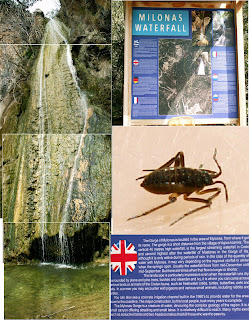 |
| Cyclamen creticus, Anacamptis collina, Fumana arabica |
We seem to have emerged from the woods unscathed
and the waterfall now lies directly ahead of us. We’ve had to take quite a
detour to get around those imposing cliffs but it should be quite a gentle
stroll today (famous last words) with plenty of opportunities to look about us.
Let’s start with a few flowers that are heralding the arrival of spring later
this month. In the shade of the rocks among the pine litter we have the white
nodding heads of the Cretan Sowbread which is a type of Cyclamen; the yellow
Fumana, a type of rock rose which we saw budding a few weeks back, is now in
full flower; and our first orchid of the season: The Fan Lipped Orchid.
 |
| Lucilia ceasar visiting Euphorbia dendroides |
Many flowers have lovely scents to attract insect
pollinators which we greatly appreciate but some, like this tree spurge here,
have a pungent odour which we find somewhat off-putting. Some people have
likened it to a decomposing corpse. Fortunately I have never had the experience
of smelling a three day dead body so I can neither confirm nor deny but it
certainly seems to be attracting these Greenbottles. Not everybody’s favourite
insect but they’re quite beautiful when you look at them closely and useful
too. Not only do they help to cleanse the planet of rotting bodies but their
maggots (which feed on dead animal tissue) have been, and still are, used
medically in maggot therapy. They are dropped into a wound such as an ulcer
where they not only remove all the dead tissue but also secrete antimicrobial
fluids that sterilise the wound.
 |
| Cicindela campestris mating |
Have you noticed these little green beetles
scurrying around on the sandy ground? They’re Tiger Beetles, so called because
of their predatory nature. Notice the way that they sprint and stop in a series
of jerky runs. This is because they run too fast to see where they’re going and
they have to stop and visually reorient themselves. They hold their antennae
straight out in front of them to stop them bumping into things. There’s a pair
mating here look (in graphic detail if you look closely). I hope he wasn’t
running at full tilt when he commenced – the female would have got the shock of
her life.
 |
| Chalcides ocellata, Rumina decollata, Julidae family |
We’re nearly there now and I see that we’re into
stone flipping territory so let’s see if anyone is at home. Now here’s a
strange group of bedfellows. An Ocellated skink, still hibernating by the way
he’s remaining immobile and blinking at me sleepily, three Decollate snails and
a Julid millipede. I say odd bedfellows because a skink’s diet generally
includes snails and millipedes although I believe that this particular species
prefers spiders and beetles. I wonder if the snails and millipede know that? It
still seems like us cuddling up to a hibernating bear but nature is full of
surprises.
 |
| Veliidae family |
Well, here it is at last, the Milonas Waterfall, at 40m vertical drop it is the highest streaming waterfall in Crete. There’s a lovely pool here at the base that looks ripe for a bit of pond dipping so let’s go for a paddle. That’s rather refreshing isn’t it? We seem to have some small bugs swimming on the surface that may be worth a closer look. They’re rather quick and not easy to photograph but the body shape and size, the fact that they’re not doing the backstroke and the plated appearance of the abdomen make me think that they are Riffle Bugs. These are small predatory water striders typical of this sort of habitat but I’m not 100% sure. What do you think?
The Extra Bit
You know, that pool does look rather inviting, did you
bring a towel? Come on then. Let’s go for a dip. Don’t be a sissy, the snow’s
melted and there’s not even any ice on the surface.
Time for a dip (short video): https://youtu.be/RUybOxhLqRg






No comments:
Post a Comment